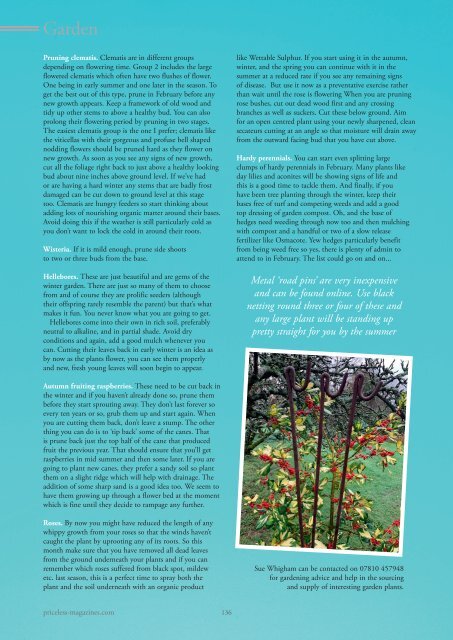Wealden Times | WT225 | Jan & Feb 2021| Education supplement inside
Wealden Times - The lifestyle magazine for the Weald
Wealden Times - The lifestyle magazine for the Weald
Create successful ePaper yourself
Turn your PDF publications into a flip-book with our unique Google optimized e-Paper software.
Garden<br />
Pruning clematis. Clematis are in different groups<br />
depending on flowering time. Group 2 includes the large<br />
flowered clematis which often have two flushes of flower.<br />
One being in early summer and one later in the season. To<br />
get the best out of this type, prune in <strong>Feb</strong>ruary before any<br />
new growth appears. Keep a framework of old wood and<br />
tidy up other stems to above a healthy bud. You can also<br />
prolong their flowering period by pruning in two stages.<br />
The easiest clematis group is the one I prefer; clematis like<br />
the viticellas with their gorgeous and profuse bell shaped<br />
nodding flowers should be pruned hard as they flower on<br />
new growth. As soon as you see any signs of new growth,<br />
cut all the foliage right back to just above a healthy looking<br />
bud about nine inches above ground level. If we’ve had<br />
or are having a hard winter any stems that are badly frost<br />
damaged can be cut down to ground level at this stage<br />
too. Clematis are hungry feeders so start thinking about<br />
adding lots of nourishing organic matter around their bases.<br />
Avoid doing this if the weather is still particularly cold as<br />
you don’t want to lock the cold in around their roots.<br />
Wisteria. If it is mild enough, prune side shoots<br />
to two or three buds from the base.<br />
Hellebores. These are just beautiful and are gems of the<br />
winter garden. There are just so many of them to choose<br />
from and of course they are prolific seeders (although<br />
their offspring rarely resemble the parent) but that’s what<br />
makes it fun. You never know what you are going to get.<br />
Hellebores come into their own in rich soil, preferably<br />
neutral to alkaline, and in partial shade. Avoid dry<br />
conditions and again, add a good mulch whenever you<br />
can. Cutting their leaves back in early winter is an idea as<br />
by now as the plants flower, you can see them properly<br />
and new, fresh young leaves will soon begin to appear.<br />
like Wettable Sulphur. If you start using it in the autumn,<br />
winter, and the spring you can continue with it in the<br />
summer at a reduced rate if you see any remaining signs<br />
of disease. But use it now as a preventative exercise rather<br />
than wait until the rose is flowering When you are pruning<br />
rose bushes, cut out dead wood first and any crossing<br />
branches as well as suckers. Cut these below ground. Aim<br />
for an open centred plant using your newly sharpened, clean<br />
secateurs cutting at an angle so that moisture will drain away<br />
from the outward facing bud that you have cut above.<br />
Hardy perennials. You can start even splitting large<br />
clumps of hardy perennials in <strong>Feb</strong>ruary. Many plants like<br />
day lilies and aconites will be showing signs of life and<br />
this is a good time to tackle them. And finally, if you<br />
have been tree planting through the winter, keep their<br />
bases free of turf and competing weeds and add a good<br />
top dressing of garden compost. Oh, and the base of<br />
hedges need weeding through now too and then mulching<br />
with compost and a handful or two of a slow release<br />
fertilizer like Osmacote. Yew hedges particularly benefit<br />
from being weed free so yes, there is plenty of admin to<br />
attend to in <strong>Feb</strong>ruary. The list could go on and on...<br />
Metal ‘road pins’ are very inexpensive<br />
and can be found online. Use black<br />
netting round three or four of these and<br />
any large plant will be standing up<br />
pretty straight for you by the summer<br />
Autumn fruiting raspberries. These need to be cut back in<br />
the winter and if you haven’t already done so, prune them<br />
before they start sprouting away. They don’t last forever so<br />
every ten years or so, grub them up and start again. When<br />
you are cutting them back, don’t leave a stump. The other<br />
thing you can do is to ‘tip back’ some of the canes. That<br />
is prune back just the top half of the cane that produced<br />
fruit the previous year. That should ensure that you’ll get<br />
raspberries in mid summer and then some later. If you are<br />
going to plant new canes, they prefer a sandy soil so plant<br />
them on a slight ridge which will help with drainage. The<br />
addition of some sharp sand is a good idea too. We seem to<br />
have them growing up through a flower bed at the moment<br />
which is fine until they decide to rampage any further.<br />
Roses. By now you might have reduced the length of any<br />
whippy growth from your roses so that the winds haven’t<br />
caught the plant by uprooting any of its roots. So this<br />
month make sure that you have removed all dead leaves<br />
from the ground underneath your plants and if you can<br />
remember which roses suffered from black spot, mildew<br />
etc. last season, this is a perfect time to spray both the<br />
plant and the soil underneath with an organic product<br />
Sue Whigham can be contacted on 07810 457948<br />
for gardening advice and help in the sourcing<br />
and supply of interesting garden plants.<br />
priceless-magazines.com<br />
136


















